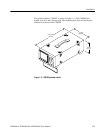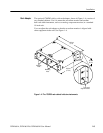
Installation
WFM 601A, WFM 601E & WFM 601M User Manual
1–13
You can use the waveform monitor to check serial digital signals around a
routing switcher. It is possible to look at all the inputs to the switcher with the use
of a patch panel and the serial monitor as shown in Figure 1–7.
Serial
sources
Patch panel
Waveform Monitor
(rear panel)
SER A
Loop-through input
SER B
Loop-through input
Serial video output signal
Serial router
Output
Figure 1–7: Monitoring serial digital signals around a routing switcher
The waveform monitor uses passive loop-through serial inputs, similar in concept
to those used in baseband video equipment. Accordingly, the loop-through must
be terminated externally. It is important that this external termination meet
accuracy and return loss requirements.
If the waveform monitor is installed to monitor an operating link, the destination
receiver and the connecting cable serve as the termination. This monitoring
connection is best because it checks the performance of the entire serial path. The
return loss of the waveform monitor is sufficiently high that, in most cases, the
destination receiver sets the system return loss.
In cases where the waveform monitor is placed at the end of a link, a BNC
termination must be installed on one side of the loop-through connector. The
termination must be 75 W and DC coupled (good return loss extends to DC).
Return loss should exceed 25 dB from 10 kHz to 270 MHz. The supplied 75 W
terminators meet these requirements.
A terminator can be inspected for return loss problems using the WFM 601M or
WFM 601E waveform monitor and a serial source with low aberrations, such as
the Tektronix TG 2000 mainframe with a DVG1 Generator module. Connect the
generator serial output to one side of the waveform monitor loop-through
connector and install the terminator on the other side. Select the EYE mode and
observe the Eye Pattern, paying particular attention to leading edge aberrations.
Line Termination


















